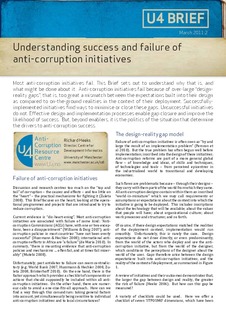Understanding success and failure of anti-corruption initiatives
Report
Permanent lenke
http://hdl.handle.net/11250/2474670Utgivelsesdato
2011-04-01Metadata
Vis full innførselSamlinger
- Publications [1488]
Originalversjon
Bergen: Chr. Michelsen Institute (U4 Brief 2011:2) 4 p.Sammendrag
Most anti-corruption initiatives fail. This Brief sets out to understand why that is, and what might be done about it. Anti-corruption initiatives fail because of over-large “design-reality gaps”; that is, too great a mismatch between the expectations built into their design as compared to on-the-ground realities in the context of their deployment. Successfully implemented initiatives find ways to minimise or close these gaps. Unsuccessful initiatives do not. Effective design and implementation processes enable gap closure and improve the likelihood of success. But, beyond enablers, it is the politics of the situation that determine the drivers to anti-corruption success.
